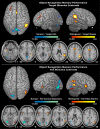Neuroanatomical correlates of malingered memory impairment: event-related fMRI of deception on a recognition memory task
- PMID: 18465389
- PMCID: PMC2875084
- DOI: 10.1080/02699050802084894
Neuroanatomical correlates of malingered memory impairment: event-related fMRI of deception on a recognition memory task
Abstract
Primary objective: Event-related, functional magnetic resonance imaging (fMRI) data were acquired in healthy participants during purposefully malingered and normal recognition memory performances to evaluate the neural substrates of feigned memory impairment.
Methods and procedures: Pairwise, between-condition contrasts of neural activity associated with discrete recognition memory responses were conducted to isolate dissociable neural activity between normal and malingered responding while simultaneously controlling for shared stimulus familiarity and novelty effects. Response timing characteristics were also examined for any association with observed between-condition activity differences.
Outcomes and results: Malingered recognition memory errors, regardless of type, were associated with inferior parietal and superior temporal activity relative to normal performance, while feigned recognition target misses produced additional dorsomedial frontal activation and feigned foil false alarms activated bilateral ventrolateral frontal regions. Malingered response times were associated with activity in the dorsomedial frontal, temporal and inferior parietal regions. Normal memory responses were associated with greater inferior occipitotemporal and dorsomedial parietal activity, suggesting greater reliance upon visual/attentional networks for proper task performance.
Conclusions: The neural substrates subserving feigned recognition memory deficits are influenced by response demand and error type, producing differential activation of cortical regions important to complex visual processing, executive control, response planning and working memory processes.
Figures

References
-
- Bianchini KJ, Mathias CW, Greve KW. Symptom validity testing: a critical review. Clin Neuropsychol. 2001;15:19–45. - PubMed
-
- Allen MD, Bigler ED, Larsen J, Goodrich-Hunsaker NJ, Hopkins RO. Functional neuroimaging evidence for high cognitive effort on the Word Memory Test in the absence of external incentives. Brain Inj. 2007;21:1425–1428. - PubMed
-
- Wertheimer M, King DB, Peckler MA, Raney S, Schaef RW. Carl Jung and Max Wertheimer on a priority issue. J Hist Behav Sci. 1992;28:45–56. - PubMed
-
- Goldstein ER. Reaction times and the consciousness of deception. Am J Psychol. 1923;34:562–581.
Publication types
MeSH terms
Grants and funding
LinkOut - more resources
Full Text Sources
Medical
